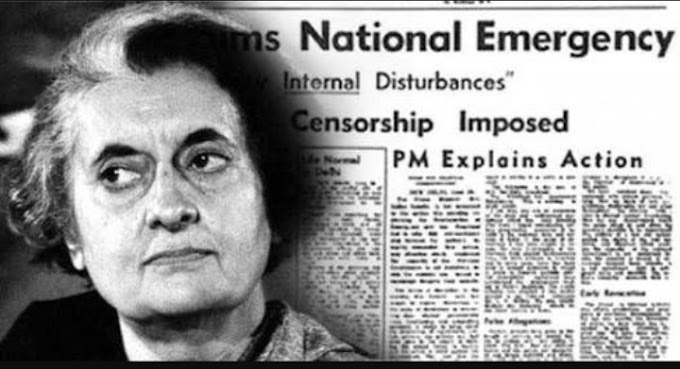 |
| Indira Gandhi |
What is emergency?
In simple language, emergency means such a serious situation where we have to take a decision immediately. For example, suppose if a house catches fire, what will we do in such a time? Can't afford to spend too much time, so we have to make some decisions immediately on how to get people out of the fire, how to call for help, what to do till help comes, etc.
Similarly, when a serious situation arises in our country like external aggression, war or armed rebellion, and in such a situation, when the security of India or any of its territories is threatened, The President is empowered to invoke National Emergency under Article 352 of the Constitution of India.
Types of Emergency in Indian Constitution-
The Constitution of India empowers the President to declare three types of emergencies. National Emergency under Article 352, State Emergency (President's Rule) under 356, and Financial Emergency under Article 360.
1. National Emergency-
Under Article 352 of the Constitution, if the President feels that a serious situation has arisen in the country like war, external aggression or armed rebellion, and now the reason is to threaten the security of the country or any region, then such a situation in the country There is a proposal to declare a national emergency.
2. State Emergency (President's Rule)-
Under Article 356 of the Constitution, when the President feels that the State Government is unable to act in accordance with the constitutional provisions, in such a situation the Central Government can take direct control of the state machinery and declare President's rule here.
3. Financial emergency-
Under Article 370 of the Constitution, if the President feels that the financial stability of the country or any region of the country is threatened, then in such a situation a financial emergency can be declared. Note- This type of emergency has never been enforced in the country till date.
 |
| Former President of India Fakhruddin Ali Ahmed with Indira Gandhi |
This emergency was lifted on 21 March 1977. The 19 months between this emergency period are still counted in the dark days of the history of independent India. This was the most controversial and undemocratic period in the history of independent India. This was the time when the arrests of opposing leaders started on the orders of the then Prime Minister, the press was banned, bullets were fired on those protesting in Delhi and forcibly sterilization of people.
Before proceeding further, we should also know what was the reason due to which Indira Gandhi had to take a big decision like imposing emergency in the country. Was there really such activities going on in the country, due to which emergency had to be imposed in the country, or Indira Gandhi had some personal reasons. Let's read further-
Reasons for imposing emergency-
The biggest reason behind Indira Gandhi's imposition of Emergency was Rajnarayan. After losing 1971's Lok Sabha Elections to Indira Gandhi in RaeBareli, Rajnarayan filed a case against her saying that she won the election using some unethical ways. 4 years later, on 12 June 1975, the Allahabad High Court ruled on this case, which was in favor of Rajnarayan.
The court convicted Indira Gandhi on 14 charges including bribing voters, misusing government machinery, misusing government resources. The High Court disqualified Indira Gandhi to hold office and contest elections for the next 6 years.
 |
| Rajnarayan with his lawyer Shanti Bhushan after winning the case |
The elections of 1976 were close and in such a situation Indira Gandhi had to contest this election in any case. However, because of this decision Indira Gandhi was seen to have her political life going towards the dark, and the only way to prevent it - Emergency in the country. Indira Gandhi declared emergency in the country after next few days.
Events-
 | |
|
 |
| George Fernandes is called 'rebel without a pause'. His picture in the chains tells the whole story of the Emergency |
 |
| Narendra Modi during the Emergency. He had to change his disguise to avoid arrest. |
- Arrests of opposition leaders- From the beginning of 1976, Indira Gandhi ordered the arrest of opposition leaders. Many leaders like Jayaprakash Narayan were arrested. The Congress was also afraid of opposition in its own party, so Chandrashekhar, a member of the Congress executive and Ramdhan, the secretary of the parliamentary party, were also arrested. Many leaders had fled the country for fear of arrest.
- Rapid change in constitution- In the first week of the Emergency, Indira Gandhi suspended Article 14 (Right to Equality), Article 21 (Right to Life and Property Protection), and Article 22 (Right to Appear before the Court within 24 hours of arrest) of the Constitution. done. In January 1976, Article 19 was also suspended which gave freedom of expression, publication, association and assembly.
- Press censorship- All types of media such as newspapers, TV, radio etc. were banned. Now the newspaper can print only what the government has allowed. Even to prevent the publication of the English newspaper "Indian Express", the power supply of the printing press was shut down.
- Sterilization campaign- In this campaign conducted under the leadership of Sanjay Gandhi, a large number of people were forced out of their homes to undergo sterilization. Even to increase the figures, 65 70 years old people were caught and sterilized.
 |
| RK Laxman's cartoon on press freedom during emergency (this cartoon was also printed outside India) |


0 Comments
Comment Policy in force from 09 august 2019 **Please be aware that all comments made are moderated and SPAM will not be published. **Comments must relate to the post topic. Read our Comment Policy